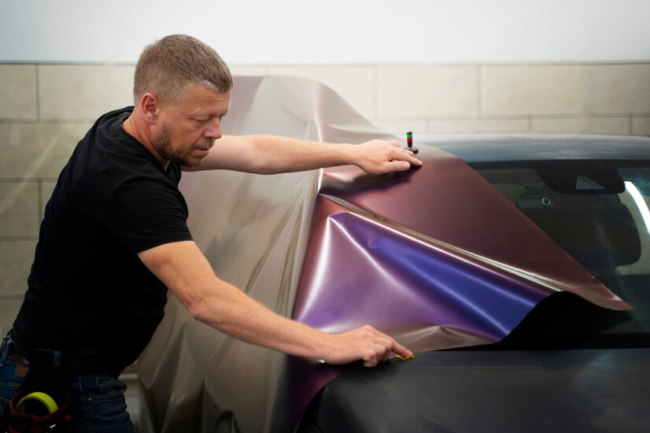Window tinting, a process involving the application of a thin film to glass surfaces, serves multiple purposes beyond mere aesthetics. This film comprises various materials, including dyes, metals, ceramics, carbon, or crystalline substances, engineered to alter the properties of the glass.
The primary objective of window tinting is to modify the amount of light passing through the glass while addressing specific concerns like UV protection, heat reduction, glare control, and privacy enhancement. Whether for automobiles, residential homes, commercial buildings, or specialized applications, window tinting has evolved from a luxury modification to an essential feature offering numerous functional benefits.
Brief History of Window Tinting
The roots of window tinting can be traced back to the early 1960s when the automotive industry primarily adopted it to mitigate the sun’s harsh effects. Initially, tinting was a rudimentary process involving applying a dark film to windows, mainly to reduce glare and provide some privacy. Over time, advancements in technology revolutionized the tinting industry, introducing various types of films with enhanced properties and applications.
Importance of Window Tinting
Beyond its aesthetic appeal, window tinting holds significant practical importance in modern-day scenarios. The changing climate patterns and increased exposure to harmful UV rays have amplified the need for protective measures. Window tinting serves as a shield against these external elements, offering more than just an alteration in appearance.
Types of Window Tinting Films
Dyed Window Tint Film
Dyed films are among the most common and economical options available. They consist of a dye layer placed between an adhesive layer and protective outer coating. These films absorb solar heat and offer a moderate level of UV protection. However, they are more prone to fading over time compared to other film types.
Metalized Window Tint Film
Metalized films incorporate tiny metallic particles within the film layers to reflect heat and UV rays away from the window. These films provide superior heat rejection and can enhance a vehicle’s aesthetics. However, their metallic content may interfere with electronic signals, including cell phone and GPS reception.
Ceramic Window Tint Film
Ceramic films are engineered with advanced technology, utilizing ceramic particles or nano-ceramic coatings. These films excel in blocking infrared heat while allowing maximum visible light transmission. They offer excellent UV protection without interfering with electronic signals. Despite being relatively more expensive, their durability and performance make them a preferred choice for many.
Carbon Window Tint Film
Carbon-based films incorporate carbon particles within the film layers. They provide good heat resistance, effectively blocking infrared rays while maintaining a sleek appearance. These films are known for their enhanced durability and resistance to fading compared to dyed films.
Crystalline Window Tint Film
Crystalline films represent the pinnacle of window tinting technology. Engineered with multiple layers using nanotechnology, these films provide outstanding clarity, allowing high visible light transmission while still blocking UV and infrared rays. Their superior performance in heat rejection without compromising visibility makes them an optimal choice for those seeking high-quality window tinting.

Benefits of Window Tinting
UV Protection
One of the paramount advantages of window tinting is its ability to block harmful UV rays. These rays can cause skin damage and contribute to the fading of interior upholstery and furnishings. Tinted films act as a barrier, significantly reducing UV exposure, providing a safer and healthier environment inside vehicles and buildings.
Heat Reduction
Window tinting significantly diminishes heat transfer through glass. Films like ceramic or crystalline types are particularly effective in blocking infrared rays, minimizing heat buildup within the interiors. This results in a cooler and more comfortable environment, reducing reliance on air conditioning and contributing to energy savings.
Glare Reduction
Glare from direct sunlight or headlights can be distracting and uncomfortable. Tinted films reduce glare, enhancing visibility and reducing eye strain, thereby improving safety, especially while driving during bright daylight or at night.
Enhanced Privacy
Tinted windows offer increased privacy by limiting the visibility of interiors from the outside. This is beneficial for both personal comfort and security, making it harder for potential intruders to peer inside vehicles or buildings.
Legal Regulations on Window Tinting
- Salida Window Tinting Laws: Salida, like many other places, has specific regulations regarding the darkness and reflectiveness of window tints. Adhering to these laws is crucial to avoid fines or legal issues.
- Visible Light Transmission (VLT) Limits: style=”font-weight: 400;”>VLT refers to the amount of visible light that can pass through the tinted film. Different windows (front, rear, and side) might have varying VLT limits, so it’s essential to comply with these specifications.
- Front, Rear, and Side Window Regulations: Regulations often differ for front, rear, and side windows, considering factors like driver visibility and safety. Understanding these regulations ensures compliance while benefiting from the advantages of window tinting.
Window Tinting Process
- Preparing the Windows: Before applying the tint film, thorough cleaning of the windows is essential. Any dust, dirt, or debris can affect the adhesion of the film, leading to imperfections.
- Application of Tint Film: The application process requires precision and expertise. It involves carefully placing and smoothing out the film on the interior surface of the window, ensuring there are no air bubbles or creases.
- Post-Installation Care: After installation, allowing the film to cure properly is vital. Avoid rolling down windows or cleaning them for a specific duration as per the installer’s instructions to ensure the film adheres correctly.
Choosing the Right Window Tint
Considering Tint Darkness
The darkness of the tint is measured by its visible light transmission (VLT) percentage. Choosing the right darkness level depends on personal preferences and legal regulations.
Evaluating Tint Performance
Different tint materials offer varying levels of UV protection, heat reduction, and glare control. Understanding the performance of each type helps in making an informed decision.
Cost and Quality Considerations
Balancing the quality of the tint film with the associated cost is crucial. Investing in higher-quality films might incur a higher initial cost but could offer better long-term benefits.
DIY vs. Professional Installation
- Pros and Cons of DIY Tinting: DIY tinting kits are available, but they require skill and precision. While it may save money, improper installation can result in subpar outcomes.
- Benefits of Professional Installation: Professional installers possess the expertise and tools necessary for precise application, ensuring a seamless finish and maximizing the film’s effectiveness.
Maintaining Window Tinting
Cleaning Tips
Using mild, ammonia-free cleaners and soft materials for cleaning helps preserve the tint film without causing damage.
Avoiding Damage
Avoid using abrasive materials or sharp objects near tinted windows to prevent scratching or peeling of the film.
Repairing Torn or Damaged Tint Film
Promptly addressing any damages such as tears or scratches can prevent further deterioration of the tint film.
Common Myths about Window Tinting
Tinted Windows and Vehicle Inspections
There’s a misconception that tinted windows lead to failed vehicle inspections. However, following legal regulations ensures compliance without any inspection issues.
Tinted Windows and Safety Concerns
Contrary to beliefs, properly installed window tint does not compromise driver visibility or safety; in fact, it can enhance both.
Removing Tint Film Damaging Windows
When removed correctly, tint films do not damage windows. Professional removal ensures minimal residue and damage.
Window Tinting Applications Beyond Cars
Residential Window Tinting
Window tinting in residences offers similar benefits as in vehicles, such as UV protection, heat reduction, and enhanced privacy. Additionally, it can contribute to energy efficiency by reducing the need for excessive air conditioning.
Commercial Window Tinting
Businesses benefit from window tinting by creating a more comfortable environment for employees and customers. It also aids in reducing glare on computer screens and protecting merchandise from sun damage.
Specialized Uses
Beyond conventional applications, window tinting finds use in specialized fields like aerospace and marine industries, where it serves purposes ranging from UV protection to privacy enhancement.
Environmental Impact of Window Tinting
- Energy Efficiency Benefits: By reducing heat transfer, window tinting aids in energy conservation. It minimizes the reliance on air conditioning, thereby lowering carbon emissions.
- Sustainability of Window Films: Some tinting films are designed with eco-friendly materials, contributing to sustainable practices and reducing environmental impact.
Future Trends in Window Tinting
Advancements in Tinting Technology
Ongoing research and development lead to innovations such as self-healing films or those capable of altering transparency based on external conditions.
Smart Window Tinting
Integration of smart technologies may lead to window films that respond to environmental changes or user commands, offering dynamic control over light transmission.
Eco-Friendly Window Films
Continued focus on sustainable materials and production processes aims to create window films that have minimal environmental impact throughout their life cycle.
Conclusion
Exploring the intricacies of window tinting in Salida has revealed an array of benefits and considerations for consumers. Quality Auto Glass Tint Inc, with its commitment to excellence and expertise in window tinting solutions, stands as a reliable resource for those seeking professional services in the area. Our comprehensive guide has shed light on the advantages of window tinting, ranging from UV protection and increased privacy to enhanced aesthetics and temperature control. With our dedication to quality and customer satisfaction, we invite you to contact us at (209) 900-8269 for expert assistance tailored to your specific needs.





